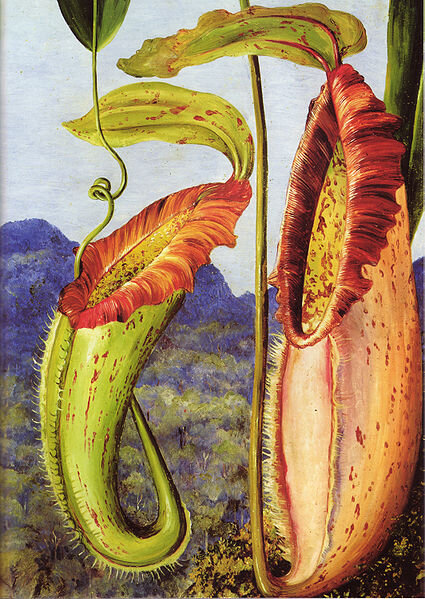Marianne North (1830 – 1890)
/Marianne north, unknown photographer, 1880s, npg.
At Kew Gardens there is the most extraordinary building that literally takes your breath away when you walk inside: Opened in 1882, the Marianne North Gallery is crammed with over 800 vibrant oil paintings mainly of plants (but also landscapes and local buildings and people) and just under 250 different timber panels. The paintings are hung, according to the art critic Wilfred Blunt ‘like a gigantic botanical postage-stamp album’ and vary in size from a few square inches to a life sized Chilean Puya whitei (at 40 inches). Even the backs of the seat rests get the same treatment, being covered in more paintings. Marianne financed and gifted the gallery to Kew, overseeing all aspects of its creation, including designing and painting the friezes and arranging the paintings. She clearly also had a sense of humour for when her request for refreshments in the gallery were turned down she painted tea and coffee plants around the doors.
Marianne came from a cultured, wealthy family and had spent many months travelling in Europe. She was a keen gardener and painter and in 1865 was introduced to oil painting: ‘being a vice like dram drinking, almost impossible to leave off once it gets possession of one’. She was extremely close to her father, and when he died, she was grief stricken and recounts in her memoir:
for nearly forty years he had been my one friend and companion, and now I had to learn to live without him, and to fill my life with other interests as I best might. I wished to be alone, I could not bear to talk of him or of anything else.
Marianne sold the family home and embarked on a life of painting and solo travelling (with servants to carry her equipment). The Rani of Sarawak described her as having: ‘skirts kilted up to the knees and heel-less wellington boots, as though born for Borneo jungles’. Between 1871 and 1885 she visited America, Canada, Jamaica, Brazil, Japan, Singapore, Malaysia, Indonesia, Sri Lanka, India, Australia, New Zealand, South Africa, the Seychelles, Chile and Tenerife. She recorded several new species of plants, including Nepenthes northiana from Sarawak, Malaysia, which was named in her honour by the director of Kew Sir Joseph Dalton Hooker.
nepenthes northiana, marianne north, kew org.
She painted the plants she saw in the context of their habitat, and by working in oils created a rich and vivid record of exotic plants and places that proved to be immensely popular to the public back home. This was at a time when long-distance travel was arduous and not for the faint-hearted; when explorers usually wrote or talked about their adventures and photography was still in its infancy (and certainly not in colour). When these dazzling and exotic paintings were displayed which brought to life the natural wonders of the world they were an immediate sensation and established her reputation as a botanical explorer and painter.
In 1885 Marianne re-arranged the paintings in her gallery by geographical distribution, which took her a year to finish. In the fourteen years that she was painting and travelling she had completed 832 paintings. She then retired to the country where she continued to garden and to write her memoirs:
The recollections of my happy life will also be a help to me in my old age. No life is so charming as a country one in England, and no flowers are sweeter or more lovely than the primroses, cowslips, bluebells and violets which grow in abundance all round me here.
To look again at the photo of Marianne taken on the porch outside her house looking every inch the Victorian matriarch and know a little of the life she lived without complaint and of the treasure that she bequeathed is humbling.



